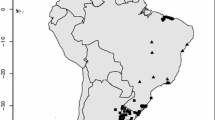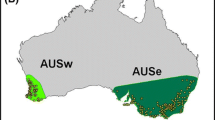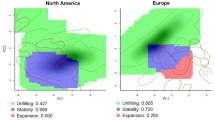Abstract
Biological invasions are one of the main threats to biodiversity worldwide, and understanding the mechanisms allowing invasive species to colonize their new environments is critical to the management of invasive populations. One particular aspect of invasion biology is to define the environmental conditions within which invasive species can persist (i.e. their ecological niche) to get insights on the potential role of adaptation in successful invasions, as well as to predict future invasion. Here, we use multiple correlative species distribution models and metrics of niche expansion and stability to investigate the worldwide invasion of the spotted-wing drosophila, Drosophila suzukii. By modeling the climatic niche of D. suzukii from occurrence data in its native and invasive ranges, we tested if a shift in the realized niche has occurred during invasion. Furthermore, we use recent population genetics work on the invasion history of the species to test whether invasive populations have preferentially invaded areas with climatic conditions more similar to the ones in their precise area of origin. Overall, our results show that D. suzukii displays a wide climatic niche and suggest that the species’ success in the invaded ranges may result from the absence of environmental challenges upon colonization. Furthermore, we show that the use of different geographical backgrounds can impact the outputs of niche comparisons and advice using complementary methods in the study of niche dynamics during biological invasions.





Similar content being viewed by others
References
Adrion JR, Kousathanas A, Pascual M, Burrack HJ, Haddad NM, Bergland AO, Machado H, Sackton TB, Schlenke TA, Watada M et al (2014) Drosophila suzukii: the genetic footprint of a recent, worldwide invasion. Mol Biol Evol 31(12):3148–3163. https://doi.org/10.1093/molbev/msu246
Allouche O, Tsoar A, Kadmon R (2006) Assessing the accuracy of species distribution models: prevalence, kappa and the true skill statistic (TSS). J Appl Ecol 43(6):1223–1232. https://doi.org/10.1111/j.1365-2664.2006.01214.x
Araujo MB, New M (2007) Ensemble forecasting of species distributions. Trends Ecol Evol 22(1):42–47. https://doi.org/10.1016/j.tree.2006.09.010
Arca M, Mougel F, Guillemaud T, Dupas S, Rome Q, Perrard A, Muller F, Fossoud A, Capdevielle-Dulac C, Torres-Leguizamon M (2015) Reconstructing the invasion and the demographic history of the yellow-legged hornet, Vespa velutina, in Europe. Biol Invasions 17(8):2357–2371
Asplen MK, Anfora G, Biondi A, Choi D-S, Chu D, Daane KM, Gibert P, Gutierrez AP, Hoelmer KA, Hutchison WD et al (2015) Invasion biology of spotted wing Drosophila (Drosophila suzukii): a global perspective and future priorities. J Pest Sci 88(3):469–494. https://doi.org/10.1007/s10340-015-0681-z
Atallah J, Teixeira L, Salazar R, Zaragoza G, Kopp A (2014) The making of a pest: the evolution of a fruit-penetrating ovipositor in Drosophila suzukii and related species. Proc Biol Sci 281(1781):20132840. https://doi.org/10.1098/rspb.2013.2840
Barbet-Massin M, Jiguet F (2011) Back from a predicted climatic extinction of an island endemic: a future for the Corsican nuthatch. PLoS ONE 6(3):e18228
Barbet-Massin M, Jiguet F, Albert CH, Thuiller W (2012) Selecting pseudo-absences for species distribution models: how, where and how many? Methods Ecol Evol 3(2):327–338. https://doi.org/10.1111/j.2041-210X.2011.00172.x
Barbet-Massin M, Jetz W, Heikkinen R (2014) A 40-year, continent-wide, multispecies assessment of relevant climate predictors for species distribution modelling. Divers Distrib 20(11):1285–1295. https://doi.org/10.1111/ddi.12229
Beaumont LJ, Gallagher RV, Thuiller W, Downey PO, Leishman MR, Hughes L (2009) Different climatic envelopes among invasive populations may lead to underestimations of current and future biological invasions. Divers Distrib 15(3):409–420. https://doi.org/10.1111/j.1472-4642.2008.00547.x
Bombi P, D’Amen M (2012) Scaling down distribution maps from atlas data: a test of different approaches with virtual species. J Biogeogr 39(4):640–651
Broennimann O, Guisan A (2008) Predicting current and future biological invasions: both native and invaded ranges matter. Biol Lett 4(5):585–589
Broennimann O, Treier UA, Müller-Schärer H, Thuiller W, Peterson AT, Guisan A (2007) Evidence of climatic niche shift during biological invasion. Ecol Lett 10(8):701–709
Broennimann O, Fitzpatrick MC, Pearman PB, Petitpierre B, Pellissier L, Yoccoz NG, Thuiller W, Fortin M-J, Randin C, Zimmermann NE et al (2012) Measuring ecological niche overlap from occurrence and spatial environmental data. Glob Ecol Biogeogr 21(4):481–497. https://doi.org/10.1111/j.1466-8238.2011.00698.x
Broennimann O, Petitpierre B, Randin C, Engler R, Breiner F, D’Amen M, Pellissier L, Pottier J, Pio D, Mateo R (2014) ecospat: Spatial ecology miscellaneous methods. R package version, 1
Calabria G, Máca J, Bächli G, Serra L, Pascual M (2012) First records of the potential pest species Drosophila suzukii (Diptera: Drosophilidae) in Europe. J Appl Entomol 136(1–2):139–147. https://doi.org/10.1111/j.1439-0418.2010.01583.x
Da Mata RA, Tidon R, Côrtes LG, De Marco P, Diniz-Filho JAF (2010) Invasive and flexible: niche shift in the drosophilid Zaprionus indianus (Insecta, Diptera). Biol Invasions 12(5):1231–1241
Dancau T, Stemberger TL, Clarke P, Gillespie DR (2017) Can competition be superior to parasitism for biological control? The case of spotted wing Drosophila (Drosophila suzukii), Drosophila melanogaster and Pachycrepoideus vindemmiae. Biocontrol Sci Technol 27(1):3–16
Deprá M, Poppe JL, Schmitz HJ, De Toni DC, Valente VLS (2014) The first records of the invasive pest Drosophila suzukii in the South American continent. J Pest Sci 87(3):379–383. https://doi.org/10.1007/s10340-014-0591-5
dos Santos LA, Mendes MF, Krüger AP, Blauth ML, Gottschalk MS, Garcia FR (2017) Global potential distribution of Drosophila suzukii (Diptera, Drosophilidae). PLoS ONE 12(3):e0174318
Elith J, Leathwick JR (2009) Species distribution models: ecological explanation and prediction across space and time. Annu Rev Ecol Evol Syst 40:677–697
Estoup A, Ravigné V, Hufbauer R, Vitalis R, Gautier M, Facon B (2016) Is there a genetic paradox of biological invasion? Annu Rev Ecol Evol Syst 47(1):51–72. https://doi.org/10.1146/annurev-ecolsys-121415-032116
Facon B, Genton BJ, Shykoff J, Jarne P, Estoup A, David P (2006) A general eco-evolutionary framework for understanding bioinvasions. Trends Ecol Evol 21(3):130–135. https://doi.org/10.1016/j.tree.2005.10.012
Fitzpatrick MC, Hargrove WW (2009) The projection of species distribution models and the problem of non-analog climate. Biodivers Conserv 18(8):2255
Fourcade Y, Engler JO, Rödder D, Secondi J (2014) Mapping species distributions with MAXENT using a geographically biased sample of presence data: a performance assessment of methods for correcting sampling bias. PLoS ONE 9(5):e97122
Fraimout A, Debat V, Fellous S, Hufbauer RA, Foucaud J, Pudlo P, Marin JM, Price DK, Cattel J, Chen X et al (2017) Deciphering the routes of invasion of Drosophila suzukii by means of ABC random forest. Mol Biol Evol 34(4):980–996. https://doi.org/10.1093/molbev/msx050
Godefroid M, Cruaud A, Rossi JP, Rasplus JY (2015) Assessing the risk of invasion by Tephritid fruit flies: intraspecific divergence matters. PLoS ONE 10(8):e0135209. https://doi.org/10.1371/journal.pone.0135209
Guisan A, Petitpierre B, Broennimann O, Daehler C, Kueffer C (2014) Unifying niche shift studies: insights from biological invasions. Trends Ecol Evol 29(5):260–269
Gutierrez AP, Ponti L, Dalton DT (2016) Analysis of the invasiveness of spotted wing Drosophila (Drosophila suzukii) in North America, Europe, and the Mediterranean Basin. Biol Invasions 18(12):3647–3663. https://doi.org/10.1007/s10530-016-1255-6
Hauser M (2011) A historic account of the invasion of Drosophila suzukii (Matsumura) (Diptera: Drosophilidae) in the continental United States, with remarks on their identification. Pest Manag Sci 67(11):1352–1357. https://doi.org/10.1002/ps.2265
Hayes KR, Barry SC (2008) Are there any consistent predictors of invasion success? Biol Invasions 10(4):483–506
Heikkinen RK, Luoto M, Araújo MB, Virkkala R, Thuiller W, Sykes MT (2006) Methods and uncertainties in bioclimatic envelope modelling under climate change. Prog Phys Geogr 30(6):751–777
Hijmans RJ, Cameron SE, Parra JL, Jones PG, Jarvis A (2005) Very high resolution interpolated climate surfaces for global land areas. Int J Climatol 25(15):1965–1978. https://doi.org/10.1002/joc.1276
Hill MP, Chown SL, Hoffmann AA (2013) A predicted niche shift corresponds with increased thermal resistance in an invasive mite. Halotydeus destructor. Glob Ecol Biogeogr 22(8):942–951
Hill MP, Gallardo B, Terblanche JS (2017) A global assessment of climatic niche shifts and human influence in insect invasions. Glob Ecol Biogeogr 26(6):679–689
Hirzel AH, Le Lay G (2008) Habitat suitability modelling and niche theory. J Appl Ecol 45(5):1372–1381. https://doi.org/10.1111/j.1365-2664.2008.01524.x
Husson F, Josse J, Le S, Mazet J (2017) FactoMineR: multivariate exploratory data analysis and data mining. R Package Version 1.32. Available at: https://CRAN.R-project.org/package=FactoMineR
Hutchinson GE (1991) Population studies: animal ecology and demography. Bull Math Biol 53(1–2):193–213
Karageorgi M, Bracker LB, Lebreton S, Minervino C, Cavey M, Siju KP, Grunwald Kadow IC, Gompel N, Prud’homme B (2017) Evolution of multiple sensory systems drives novel egg-laying behavior in the fruit pest Drosophila suzukii. Curr Biol 27(6):847–853. https://doi.org/10.1016/j.cub.2017.01.055
Keesey IW, Knaden M, Hansson BS (2015) Olfactory specialization in Drosophila suzukii supports an ecological shift in host preference from rotten to fresh fruit. J Chem Ecol 41(2):121–128
Kellermann V, Overgaard J, Hoffmann AA, Fløjgaard C, Svenning J-C, Loeschcke V (2012) Upper thermal limits of Drosophila are linked to species distributions and strongly constrained phylogenetically. Proc Natl Acad Sci 109(40):16228–16233
Kenis M, Tonina L, Eschen R, van der Sluis B, Sancassani M, Mori N, Haye T, Helsen H (2016) Non-crop plants used as hosts by Drosophila suzukii in Europe. J Pest Sci 89(3):735–748
Kimura MT (2004) Cold and heat tolerance of drosophilid flies with reference to their latitudinal distributions. Oecologia 140(3):442–449. https://doi.org/10.1007/s00442-004-1605-4
Klick J, Yang W, Walton V, Dalton D, Hagler J, Dreves A, Lee J, Bruck D (2016) Distribution and activity of Drosophila suzukii in cultivated raspberry and surrounding vegetation. J Appl Entomol 140(1–2):37–46
Lambrinos JG (2004) How interactions between ecology and evolution influence contemporary invasion dynamics. Ecology 85(8):2061–2070
Langille AB, Arteca EM, Ryan GD, Emiljanowicz LM, Newman JA (2016) North American invasion of spotted-wing Drosophila (Drosophila suzukii): a mechanistic model of population dynamics. Ecol Model 336:70–81. https://doi.org/10.1016/j.ecolmodel.2016.05.014
Lecocq T, Rasmont P, Harpke A, Schweiger O (2016) Improving international trade regulation by considering intraspecific variation for invasion risk assessment of commercially traded species: the Bombus terrestris Case. Conserv Lett 9(4):281–289. https://doi.org/10.1111/conl.12215
Lee CE (2002) Evolutionary genetics of invasive species. Trends Ecol Evol 17(8):386–391
Lee JC, Bruck DJ, Curry H, Edwards D, Haviland DR, Van Steenwyk RA, Yorgey BM (2011) The susceptibility of small fruits and cherries to the spotted-wing drosophila, Drosophila suzukii. Pest Manag Sci 67(11):1358–1367. https://doi.org/10.1002/ps.2225
Lombaert E, Guillemaud T, Cornuet JM, Malausa T, Facon B, Estoup A (2010) Bridgehead effect in the worldwide invasion of the biocontrol harlequin ladybird. PLoS ONE 5(3):e9743. https://doi.org/10.1371/journal.pone.0009743
Lozier JD, Mills NJ (2011) Predicting the potential invasive range of light brown apple moth (Epiphyas postvittana) using biologically informed and correlative species distribution models. Biol Invasions 13(10):2409
Marmion M, Parviainen M, Luoto M, Heikkinen RK, Thuiller W (2009) Evaluation of consensus methods in predictive species distribution modelling. Divers Distrib 15(1):59–69. https://doi.org/10.1111/j.1472-4642.2008.00491.x
Mateo RG, Broennimann O, Petitpierre B, Muñoz J, van Rooy J, Laenen B, Guisan A, Vanderpoorten A (2015) What is the potential of spread in invasive bryophytes? Ecography 38(5):480–487
Matsumura S (1931) 6000 illustrated insects of Japan-Empire, 1931, 8 + 1497-I-23 pp., 10 pis, Tokyo
Medley KA (2010) Niche shifts during the global invasion of the Asian tiger mosquito, Aedes albopictus Skuse (Culicidae), revealed by reciprocal distribution models. Glob Ecol Biogeogr 19(1):122–133. https://doi.org/10.1111/j.1466-8238.2009.00497.x
Nathan R (2006) Long-distance dispersal of plants. Science 313(5788):786–788
Peterson AT, Holt RD (2003) Niche differentiation in Mexican birds: using point occurrences to detect ecological innovation. Ecol Lett 6(8):774–782
Petitpierre B, Broennimann O, Kueffer C, Daehler C, Guisan A (2017) Selecting predictors to maximize the transferability of species distribution models: lessons from cross-continental plant invasions. Glob Ecol Biogeogr 26(3):275–287. https://doi.org/10.1111/geb.12530
Poutsma J, Loomans A, Aukema B, Heijerman T (2008) Predicting the potential geographical distribution of the harlequin ladybird, Harmonia axyridis, using the CLIMEX model. Biocontrol 53(1):103–125
Poyet M, Eslin P, Héraude M, Le Roux V, Prévost G, Gibert P, Chabrerie O (2014) Invasive host for invasive pest: when the Asiatic cherry fly (Drosophila suzukii) meets the American black cherry (Prunus serotina) in Europe. Agric For Entomol 16(3):251–259. https://doi.org/10.1111/afe.12052
Poyet M, Le Roux V, Gibert P, Meirland A, Prévost G, Eslin P, Chabrerie O (2015) The wide potential trophic niche of the asiatic fruit fly Drosophila suzukii: The key of its invasion success in temperate Europe? PLoS ONE 10(11):e0142785
Prentis PJ, Wilson JR, Dormontt EE, Richardson DM, Lowe AJ (2008) Adaptive evolution in invasive species. Trends Plant Sci 13(6):288–294. https://doi.org/10.1016/j.tplants.2008.03.004
Reznick DN, Ghalambor CK (2001) The population ecology of contemporary adaptations: what empirical studies reveal about the conditions that promote adaptive evolution. In: Microevolution rate, pattern, process. Springer, Berlin, pp 183–198
Rödder D, Engler JO (2011) Quantitative metrics of overlaps in Grinnellian niches: advances and possible drawbacks. Glob Ecol Biogeogr 20(6):915–927. https://doi.org/10.1111/j.1466-8238.2011.00659.x
Rombaut A, Guilhot R, Xuéreb A, Benoit L, Chapuis MP, Gibert P, Fellous S (2017) Invasive Drosophila suzukii facilitates Drosophila melanogaster infestation and sour rot outbreaks in the vineyards. R Soc Open Sci 4(3):170117
Schoener TW (1968) Anolis lizards of Bimini: resource partitioning in a complex fauna. Ecology 49:704–726
Schwartz MW (2012) Using niche models with climate projections to inform conservation management decisions. Biol Conserv 155:149–156
Shaw B, Brain P, Wijnen H, Fountain MT (2017) Reducing Drosophila suzukii emergence through inter-species competition. Pest Manag Sci. https://doi.org/10.1002/ps.4836
Soberón J, Peterson AT (2005) Interpretation of models of fundamental ecological niches and species’ distributional areas. Biodiv Inf 2:1–10. https://doi.org/10.17161/bi.v2i0.4
Thuiller W, Georges D, Engler R (2014) biomod2: Ensemble platform for species distribution modeling. R package version 3.1-64. http://CRAN.R-project.org/package=biomod2. Accessed Feb 2015
Tingley R, Vallinoto M, Sequeira F, Kearney MR (2014) Realized niche shift during a global biological invasion. Proc Natl Acad Sci USA 111(28):10233–10238. https://doi.org/10.1073/pnas.1405766111
Tingley R, Thompson MB, Hartley S, Chapple DG (2016) Patterns of niche filling and expansion across the invaded ranges of an Australian lizard. Ecography 39(3):270–280
Tochen S, Woltz J, Dalton D, Lee J, Wiman N, Walton V (2016) Humidity affects populations of Drosophila suzukii (Diptera: Drosophilidae) in blueberry. J Appl Entomol 140(1–2):47–57
Wares J (2005) Mechanisms that drive evolutionary change. Insights from species introduction and invasions. In: Sax DF, Stachowicz JJ, Gaines SD (eds) Species invasions: insights into ecology, evolution, and biogeography. Sinauer Associates, Sunderland, Massachusetts, pp 229–257
Warren DL, Glor RE, Turelli M (2008) Environmental niche equivalency versus conservatism: quantitative approaches to niche evolution. Evolution 62(11):2868–2883. https://doi.org/10.1111/j.1558-5646.2008.00482.x
Zhu G, Bu W, Gao Y, Liu G (2012) Potential geographic distribution of brown marmorated stink bug invasion (Halyomorpha halys). PLoS ONE 7(2):e31246
Zhu G, Gariepy TD, Haye T, Bu W (2017) Patterns of niche filling and expansion across the invaded ranges of Halyomorpha halys in North America and Europe. J Pest Sci 90(4):1045–1057
Acknowledgements
AF was supported by state funding by the Agence Nationale de la Recherche, through the LabEx ANR-10-LABX-0003-BCDiv, of the program “Investissements d’avenir” (ANR-11-IDEX-0004-02) and the ANR SWING (ANR-16-CE02-0015). The authors thank three anonymous reviewers for their constructive comments on previous versions of this manuscript. They also thank Blas M. Benito for helpful discussion and comments on the manuscript.
Author information
Authors and Affiliations
Corresponding author
Ethics declarations
Conflict of interest
The authors declare that they have no conflict of interest.
Electronic supplementary material
Below is the link to the electronic supplementary material.
Rights and permissions
About this article
Cite this article
Fraimout, A., Monnet, AC. Accounting for intraspecific variation to quantify niche dynamics along the invasion routes of Drosophila suzukii. Biol Invasions 20, 2963–2979 (2018). https://doi.org/10.1007/s10530-018-1750-z
Received:
Accepted:
Published:
Issue Date:
DOI: https://doi.org/10.1007/s10530-018-1750-z




